The Illuminated Chakras by Sacred Centers
The Importance of Chakras
by Adrian Cooper
Anyone who has read Our Ultimate Reality, Science of Being, Consciously Creating Circumstances and other such books will no doubt know of the crucial importance of Energy within all levels of the Universe, including the aspect of the Universe, of Source, that is the human body and all of its physical and non-physical characteristics.
Our ability to attract, assimilate and direct Energy effectively is absolutely fundamental to our well-Being on numerous levels, not the least of which is health.
The more we can absorb, store and direct Energy efficiently, the more control we will enjoy over our own health, abundance and happiness, and, as we discussed at length last week, the more "alive" and vibrant we will feel.
Baron Eugene Fersen refers to Energy as "Universal Life Energy", to which he dedicates much of his book and exercises to this crucially important subject - and rightly so.
However, although these books teach how to harness and direct Energy, they do not discuss another absolutely fundamental aspect of this - storing Energy.
The more Energy we can store, the more we can utilise plane and simple. And in turn the more Energy we have at our disposal, the more powerful we become, and in turn the more control we have over our own individual experiential reality at all levels.
Whereas a lack of stored Energy results in lethargy, lack of motivation, lack of health, lack of success and lack of success in attracting others, including partners, conversely the ability to store Energy will bring the opposite of these situations with the profound benefits this will bring.
So how then is Energy stored?
As humans we have an infinite number of "bodies" - the physical body followed an infinite number of non-physical or "subtle" bodies extending all the way to Source, God, of Whom we are equal aspects and expressions, and from Whom we came in the beginning.
The first subtle body, located between the physical and Astral bodies is known as the Etheric or "Energy" body.
The Energy body directly corresponds to the physical body which it in turn feeds with Energy at the corresponding Energy centres. The Energy Body also acts as an Energy interface, a sort of "step-down transformer" between the low vibrations of the physical body, and much higher vibrations of the Astral and Mental bodies - The Soul and Spirit.
The Energy body contains a large number of Energy interconnected storage points, the largest and most importance of which are the Energy Centres known mystically in the Far East and increasingly everywhere as "Chakras".
It is absolutely crucial for the Chakras to be functioning as optimally as possible in order to store the maximum usable Energy.
It should be noted that the Yogis and Tibetan Monks of the Far East dedicate their entire lives to developing the Chakras such is the importance they place upon of this aspect of development. As a result, and in conjunction with the Mind power, they enjoy powers and abilities that would be considered "super human", "supernatural" or "miraculous" to people in the west and most other cultures.
Also, healthy Chakras are important in the way we are perceived by others. Those with healthy Chakras and therefore strongly radiating vibrant Energy can attract others like magnets. For this reason for example healthy Chakras are very important for attracting a partner.
Conversely one reason why people fail to attract a partner or others in to their life are poorly developed Chakras with correspondingly low Energy and vibrations. Such people appear to others as "dull", dreary", "boring" and generally lacking charisma and attractiveness.
Even in a world where people judge based upon appearances, a vibrant Energy body will always overcome - such people always being sensed as attractive and desirable.
An analogy I sometimes use is likening the Chakras to the battery of a car. If the battery gets older it loses its capacity to "hold charge", until eventually, no matter how much the battery is charged, it will not start the engine or maintain the electrical systems of the car.
The same applies to the Chakras. Poorly developed, inefficient Chakras will not adequately support the vital systems of the body, and even if Energy exercises are performed, the Chakras will not "hold" the Energy which is being directed in to the Energy body, which will instead quickly dissipate back in to the Universe.
So it immediately becomes clear therefore that developing the Chakras generally is an important cornerstone of success and well-being at many levels.
In addition to the overall importance of the Chakras and maintaining the flow of Energy between them, each individual Chakra has a very specific and crucial function, each being an "interface"
with the Universe for very specific purposes.
So let us now review how Chakras may be defined, and the individual function and importance of each one:
The word "Chakra" is Sanskrit for "wheel" or "disk", signifying any one of the seven main Energy centres located within the Energy body. Each of these Energy centres also corresponds directly to a major physical nerve ganglia, or gland, connected to the spinal column. The Chakras also correspond to the many levels of Consciousness, Spiritual connection, developmental stages of life, colours, sounds, body functions, and much more.
The Crown Chakra: This Chakra is located around the crown of the head and relates to Consciousness as pure awareness. The Crown Chakra is our Divine connection to the inner realms of reality, to a timeless, space-less place of all-knowing. When well-developed, this Chakra brings us knowledge, wisdom, understanding, Spiritual connection, and bliss.
The Brow Chakra: This Chakra is located directly between the eyebrows and is often known as the "third eye". It is associated with the ability of "seeing", both psychically and intuitively, and it is closely associated with "Clairvoyance" or "clear seeing". A clairvoyant can perceive within the "Mind's eye" inner realms of reality beyond the physical world, particularly the Astral worlds, and can also perceive things in the physical world beyond the reach of the normal five physical senses.
Thousands of years ago, everyone possessed a highly developed brow Chakra which enabled them to maintain full contact with the inner realms of life and reality by means of Clairvoyance. However, as mankind has become increasingly focused upon the material world, the perception of the brow Chakra has steadily diminished to the point where it is largely unused today in most people.
The Brow Chakra is also the Chakra used for Visualisation - an important ability for invoking The law of Attraction. The more powerful the Visualisations projected through the Brow Chakra, the more of an impression it will create in Universal Energy, increasing the power and seed of manifestation.
The Throat Chakra: This Chakra is located in the region of the throat and is related to communication and creativity. By means of the throat Chakra, the world is experienced symbolically through vibration, such as sound representing language. It is also, therefore, the Chakra involved in "listening" to the inner realms through the more subtle vibration of communications.
The Heart Chakra: This is the middle-most of the major Chakras and the lowest part of the upper triangle of the Chakras (crown, brow, and heart), which are associated with the inner realms. The Heart Chakra is related to Love and also integrates opposites within the psyche, such as the Mind and body, male and female, persona and shadow, Ego and unity. A healthy heart Chakra allows people to love deeply and unconditionally, feel compassion, and enjoy a deep sense of peace, contentment and centredness.
The heart has always been a symbol of love in most cultures. The emotions that people associate with the physical heart actually originate from the heart Chakra of the Energy body.
The Solar Plexus Chakra: This Chakra, often known as the "power Chakra", is located in the solar plexus area or navel. It rules personal power, will and autonomy, as well as metabolism. When healthy, the solar plexus Chakra brings Energy, effectiveness, spontaneity and non-dominating power.
The Solar Plexus Chakra is also directly associated with the Subconscious Mind through which it is connected with the higher bodies and with the Ether, known as the Akasha in far Eastern cultures. Through the Solar Plexus Chakra and the Subconscious Mind we receive to our conscious Mind intuition and other communication from the inner Spirit worlds and Higher Self.
Many people will recall occasions when they have thought about something and instantly received a strange feeling in the area of the lower stomach. People often refer to such experiences as a "gut feeling" or a "sinking feeling" in the stomach. This is a communication from the inner realms or the Higher Self, and is often a confirmation or warning about a thought within the Mind. It can be a positive "gut feeling" or a negative "gut feeling". It is certainly advisable to heed such feelings and to take any appropriate actions without delay.
Most importantly, the Solar Plexus Chakra is our direct connection with Source, God and may be likened for example to an umbilical cord. Developing this Chakra therefore is to also develop our connection with God, in turn leading to God realisation which should one of the most fundamental objectives of every human being.
The Sacral Chakra: This Chakra is located around the region of the groin and is related to the water element, as well as to emotions and sexuality. It connects people to others through feelings, desires and sensations. Ideally, this Chakra brings fluidity and grace, depth of feeling, sexual fulfilment and the ability to accept change.
The Root Chakra: This Chakra is located at the base of the spine. It represents the Earth element and is related to survival instincts, as well as the connection to the physical world. Ideally, this Chakra brings good health, prosperity, security and dynamic presence.
So it can be plainly seen that healthy Chakras can and do exert a profound influence over our experiential reality and experience at all levels.
Of course - Developing the Chakras is another matter. There are many methods out there that claim to develop the Chakras, but many, if not most only result in temporary results - if that. One reason for this is that these methods rely on visualisation.
Now while visualisation is an important tool for developing the Chakras, it will not, in and of itself influence the Chakras sufficiently to make any lasting, if any changes.
The Chakras need to be directly stimulated and above all sensed.
Each Chakra resonated to its own Energy Vibration, and will therefore respond to that unique vibration.
I realise of course that there are few, if any resources available that will guide you towards successfully developing your Chakras, and so I am currently also developing resources that will finally enable you to successfully achieve this important objective in the fastest and most effective way.
SourceThe following chakra information is found at the Sacred Centers website:
The Chakras
The word chakra is Sanskrit for wheel or disk and signifies one of seven basic energy centers in the body that correspond to nerve ganglia branching out from the spinal column, as well as states of consciousness, developmental stages of life, archetypal elements, body functions, colors, sounds, and much, much more.
Together they form a profound formula for wholeness and a template for transformation.
Go Here and Click on each Chakra Image to see it come to life with a
scene from The Illuminated Chakras also shown in the video above.
 | Chakra Seven: SahasraraThought, Universal identity, oriented to self-knowledgeThis is the crown chakra that relates to consciousness as pure awareness. It is our connection to the greater world beyond, to a timeless, spaceless place of all-knowing. When developed, this chakra brings us knowledge, wisdom, understanding, spiritual connection, and bliss. |
 | Chakra Six: AjnaLight, Archetypal identity, oriented to self-reflectionThis chakra is known as the brow chakra or third eye center. It is related to the act of seeing, both physically and intuitively. As such it opens our psychic faculties and our understanding of archetypal levels. When healthy it allows us to see clearly, in effect, letting us “see the big picture.” |
 | Chakra Five: VishuddhaSound, Creative identity, oriented to self-expressionThis is the chakra located in the throat and is thus related to communication and creativity. Here we experience the world symbolically through vibration, such as the vibration of sound representing language. |
 | Chakra Four: AnahataAir, Social identity, oriented to self-acceptanceThis chakra is called the heart chakra and is the middle chakra in a system of seven. It is related to love and is the integrator of opposites in the psyche: mind and body, male and female, persona and shadow, ego and unity. A healthy fourth chakra allows us to love deeply, feel compassion, have a deep sense of peace and centeredness. |
 | Chakra Three: ManipuraFire, Ego identity, oriented to self-definitionThis chakra is known as the power chakra, located in the solar plexus. It rules our personal power, will, and autonomy, as well as our metabolism. When healthy, this chakra brings us energy, effectiveness, spontaneity, and non-dominating power. |
 | Chakra Two: SvadhisthanaWater, Emotional identity, oriented to self-gratificationThe second chakra, located in the abdomen, lower back, and sexual organs, is related to the element water, and to emotions and sexuality. It connects us to others through feeling, desire, sensation, and movement. Ideally this chakra brings us fluidity and grace, depth of feeling, sexual fulfillment, and the ability to accept change. |
 | Chakra One: MuladharaEarth, Physical identity, oriented to self-preservationLocated at the base of the spine, this chakra forms our foundation. It represents the element earth, and is therefore related to our survival instincts, and to our sense of grounding and connection to our bodies and the physical plane. Ideally this chakra brings us health, prosperity, security, and dynamic presence. |
Chakras
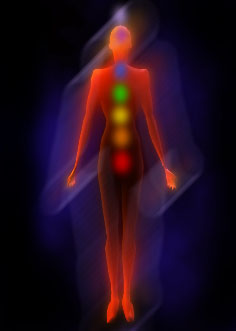
Chakra means Wheel in Sanskrit.
Consciousness and energy move from one
frequency to another in spiraling fashion.
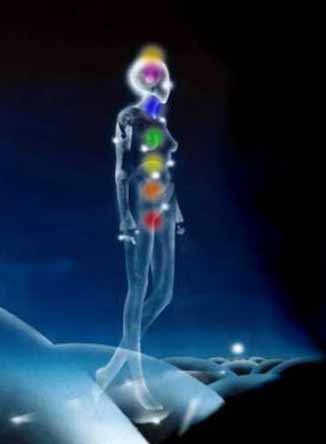
The body has energy centers that look like
spinning wheels and are called Chakras.
They allow energy to flow from
one part of the body to another.

As with all things in our reality,
they are linked to sound, light and color.
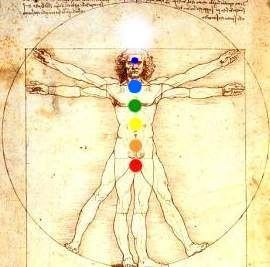
To heal, is to bring the chakras into alignment and balance

then understand the nature of creation and your purpose in it.
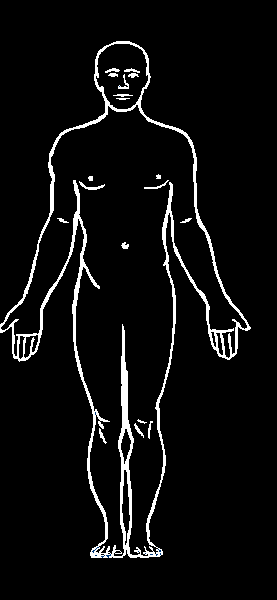
It's all in motion in the alchemy of time.
The Flow of Energy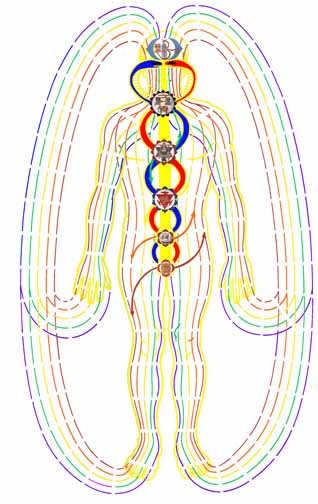
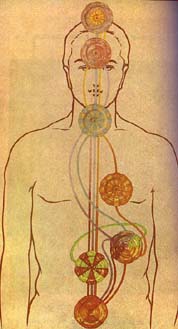
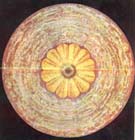
Crown Chakra
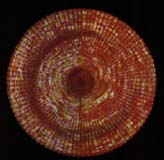
Brow Chakra
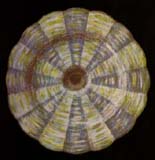
Throat Chakra
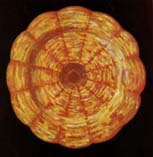
Heart Chakra
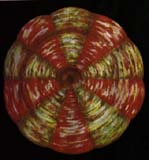
Solar Plexus
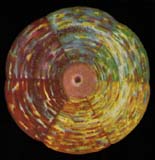
Spleen Chakra
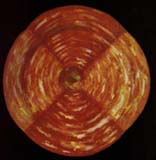
Root Chakra
Chakras above the head bring one into higher frequency.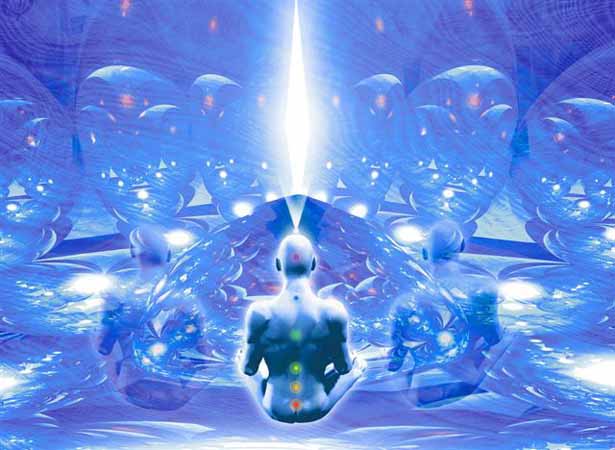
They range from 4 fingers to one foot above the crown chakra.
The highest chakra is also often referred to as the Soulstar.
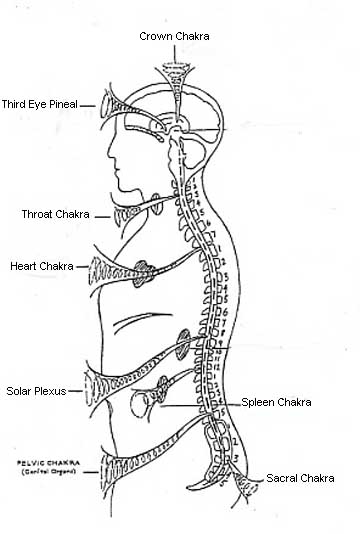
12 Around 1 Spiraling Cones of Creation
Chakra and Color Frequencies
RED
1st Chakra: Base or Root Chakra: Kundalini: Root Chakra:
Located at the base of the spine.
Earth, survival, grounding, stillness
Contains the primary 8 cells that have all of the knowledge of
creation and remain the only cells in your body that do not
change in your lifetime. It grounds us in the physical world.
ORANGE
2nd Chakra: Spleen: Located just beneath the navel, and
related to our sexual and reproductive capacity.
Blockage manifests as emotional problems or sexual guilt.
YELLOW
3rd Chakra: Solar Plexis: Seat of Emotions. Gives us a sense of personal
power in the world. Blockage manifests as anger or a sense of victimization.
GREEN
4th Chakra: Heart Chakra: Blockage can manifest as immune
system or heart problems, or a lack of compassion.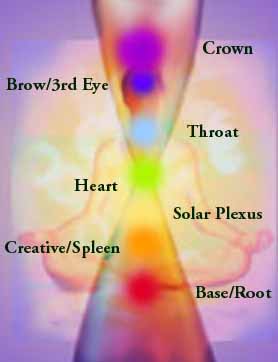
Heart Center - Seat of the Soul in the hourglass of time - Zero Point
BLUE
5th Chakra: Throat: Tied to creativity and communication.
Feels pressure when you are not communicating your emotions properly.
INDIGO
6th Chakra: Third Eye Pineal Gland:
Often connected to the forehead.
Is a physical eye at the base of the brain
with the capabilities of looking upward.
Clairvoyance, psychic abilities, imagination, dreaming
PURPLE
7th Chakra Crown: Connects you with message from higher realms.
Can be experienced as a pressure on the top of the head.
spiritual connection, understanding, knowing, bliss, God
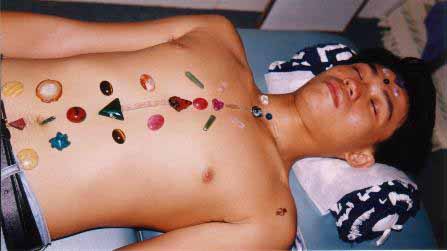
to create balance and healing.
Crystal Bowl Harmonics and Chakras
The use of quartz crystal bowls in the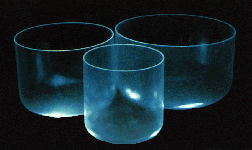
correct harmonic can activate and align chakras.
Crop Circles and Chakras
June 1996...Alton Barnes, England
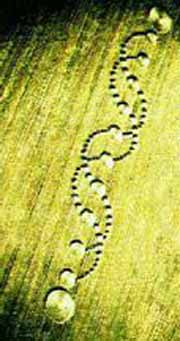
This Crop Circle allegedly depicts 12 Chakras
and the Activation of human DNA
Earth Chakra System
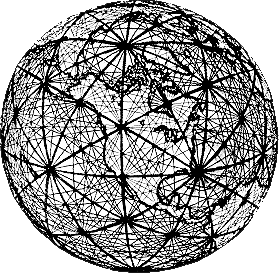
The Earth, as a living organism, has chakra centers.
They link with major grid points.
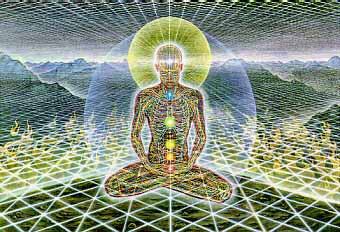
Our chakras are aligned to the Earth's grid system.
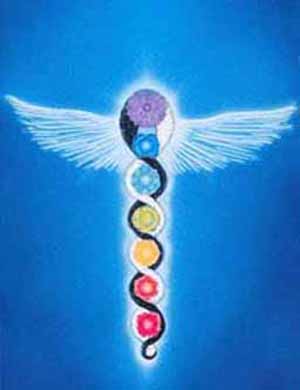
Kundalini
Caduceus and Related Symbology
DNA, Snakes, Dragons, Creation
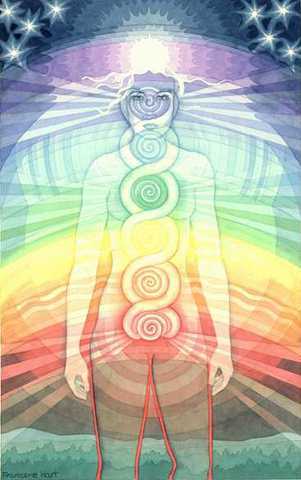
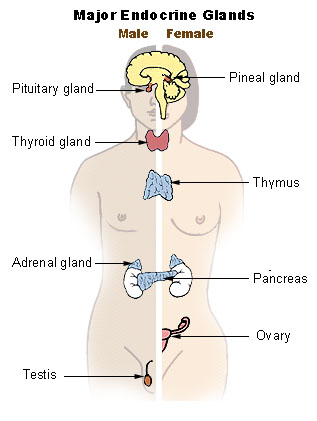
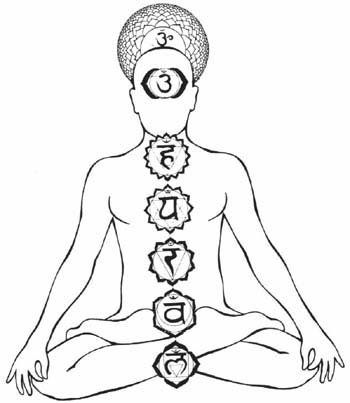
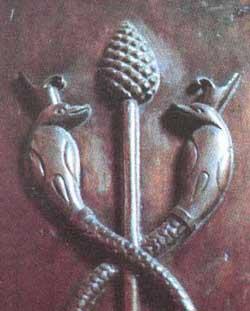
Tantra (Shakta or Shaktism) describes eight primary inner chakras:
- 1. Sahasrara
2. Ajna
3. Vishuddha
4. Anahata
5. Manipura
6. Swadhisthana
7. Muladhara
8. Bindu
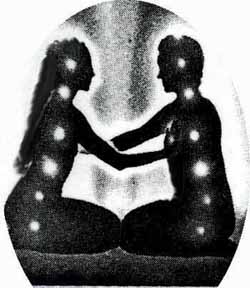
Lovers connecting their chakras
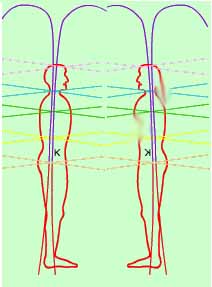
grid matrixes and auric fields.
Body, Mind and Soul
The word comes from the Sanskrit "cakra" meaning "wheel, circle", and sometimes also referring to the "wheel of life". The pronunciation of this word can be approximated in English by 'chuhkruh', with ch as in chart and both instances - the commonly found pronunciation 'shockrah' is incorrect.
The seven main chakras are described as being aligned in an ascending column from the base of the spine to the top of the head. Each chakra is associated with a certain color, multiple specific functions, an aspect of consciousness, a classical element, and other distinguishing characteristics.
The chakras are thought to vitalise the physical body and to be associated with interactions of both a physical and mental nature. They are considered loci of life energy, or prana, which is thought to flow among them along pathways called nadis.
- In Mysticism, a Nadi (plural: Nadis) is an energy channel in which prana energy flows and may connect chakras. It is not accepted by mainstream science. The main nadis include Shushumna, Ida and Pingala.
Nadis are thought to carry a life force energy known as prana in Sanskrit, or qi in Chinese-based systems. They are also said to have an extrasensory function, playing a part in empathic and instinctive responses.Nadis are sometimes viewed as extending only to the skin of the body, but are often thought to extend to the boundary of the aura.
The Ida and Pingala nadis are often seen as referring to the two hemispheres of the brain. Pingala is the extroverted, solar nadi, and corresponds to the left hand side of the brain. Ida is the introverted, lunar nadi, and refers to the right hand side of the brain.
The two nadis are stimulated through the practice of pranayama, which involves alternate breathing through left and right nostrils, which would alternately stimulate the left and right sides of the brain.The word nadi comes from the Sanskrit root nad meaning "channel", "stream", or "flow".
Traditional Chinese medicine also relies on a similar model of the human body as an energy system.
The New Age movement has led to an increased interest in the West regarding chakras. Many in this movement point to a correspondence between the position and role of the Chakras, and those of the glands in the endocrine system. Some people in New Age also claim that other chakras, besides the above, exist - for instance, ear chakras.
The chakras are described in the tantric texts the Sat-Cakra-Nirupana, and the Padaka-Pancaka, in which they are described as emanations of consciousness from Brahman, an energy which comes down from the spiritual and gradually crudifies, creating these distinct levels of chakras, and which eventually finds its rest in the Muladhara chakra.
- Muladhara is positioned close to anus, at the perineum, and it has four petals which match the vrittis of greatest joy, natural pleasure, delight in controlling passion, and blissfulness in concentration.
In Samkhya philosophy, the concept of Muladhara is that of moola prakriti, the metaphysical basis of material existence. Muladhara is the chakra that draws down spritual energy and causes it to assume a physical existence. It is like the negative pole in an electrical circuit, which provides the potential for the evolution of form.
Within this chakra resides sleeps the kundalini shakti, the great spiritual potential, waiting to be aroused and brought back up to the source from which it originated, Brahman.
Muladhara is the base from which the 3 main psychic channels, nadis, ida, pingala and sushumna, emerge.It is related to the physical processes of reproduction and excretion, and also to the various fear and guilt complexes associated with them. All a person's Samskaras ( potential karma ), are expressed here, in a physical form.
This chakra is associated with the deities Indra, Brahma and Dakini, the element Earth and the color red.
They are therefore part of an emanationist theory, like that of the kabbalah in the west, or neo-platonism. The energy that was unleashed in creation, called the Kundalini, lies coiled and sleeping, and it is the purpose of a tantric yogi to arouse this energy, and cause it to rise back up through the increasingly subtler chakras, until union with god is achieved in the Sahasrara chakra at the crown of the head.
- Sahasrara is positioned above the head or at the top of it and it has 1000 petals which are arranged in 20 layers each of them with 50 petals. For a discussion about the petal count see also petal (chakra)Often referred as thousand-petaled lotus, it is said to be the most subtle chakra in the system, relating to pure consciousness, and it is from this chakra that all the other chakras emanate. When a yogi is able to raise his or her kundalini, energy of consciousness, up to this point, the state of samadhi, or union with god, is experienced.
Apart from this primary text from India, different western authors have tried to describe the chakras, most notably the Theosophists. Many new age writers, such as the Danish author and musician Peter Kjaerulff in his book, The Ringbearers Diary, or Anodea Judith in her book Wheels of Life, have written their opinions about the chakras in great detail, including the reasons for their appearance and their functions.
The seven chakras are said by some to reflect how the unified consciousness of man (the immortal human being or the soul), is divided to manage different aspects of earthly life (body/instinct/vital energy/deeper emotions/communication/having an overview of life/contact to God). The chakras are placed at differing levels of spiritual subtletly, with Sahasrara at the top being concerned with pure consciousness, and Muladhara at the bottom being concerned with matter, which is seen simply as crudified consciousness.
The earliest known mention of chakras is found in the later Upanishads, including specifically the Brahma Upanishad and the Yogatattva Upanishad. These vedic models were adapted in Tibetan Buddhism as Vajrayana theory, and in the Tantric Shakta theory of chakras.It is the shakta theory of 7 main chakras that most people in the West adhere to, either knowingly or unknowingly, largely thanks to a translation of two indian texts, the Sat-Cakra-Nirupana, and the Padaka-Pancaka, by Sir John Woodroffe, alias Arthur Avalon, in a book entitled The Serpent Power.
This book is extremely detailed and complex, and later the ideas were developed into what is predominant western view of the Chakras by the Theosophists, and largely the controversial (in theosophical circles) C. W. Leadbeater in his book The Chakras, which are in large part his own meditations and insights on the matter.
That said, many present-day Indian gurus that incorporate chakras within their systems of philosophy do not seem to radically disagree with the western view of chakras, at least on the key points, and both these eastern and western views have developed from the Shakta Tantra school.
There are various other models of chakras in other traditions, notably in Chinese medicine, and also in Tibetan Buddhism. Even in Jewish kabbalah, the different Sephiroth are sometimes associated with parts of the body.
In Islamic Sufism , Lataif-e-Sitta ( Six Subtleties ) are considered as psychospiritual "organs" or faculties of sensory and suprasensory perception , activation of which makes a man complete .
Attempts are made to try and reconcile the systems with each other, and notably there are some successes, even between such diverged traditions as Shakta Tantra, Sufism and Kabbalism, where chakras , lataif and Sephiroth can seemingly represent the same archetypal spiritual concepts.
In Surat Shabda Yoga, initiation by an Outer Living Satguru (Sat - true, Guru - teacher) is required and involves reconnecting soul to the Shabda and stationing the Inner Shabda Master (the Radiant Form of the Master) at the third eye chakra.
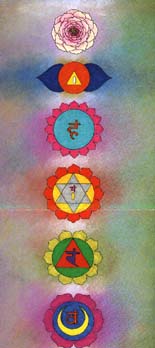
Yoga view of chakras
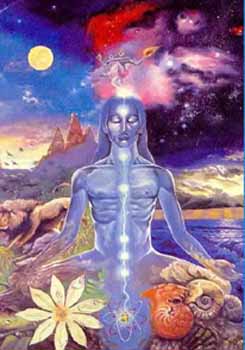
Yoga
Yoga creates balance.
Parallels have often been drawn, by supporters of the existence of chakras, between the positions and functions of the chakras, and of the various organs of the endocrine system.
The highest crown chakra is said to be the chakra of consciousness, the master chakra that controls all the others. Its role would be very similar to that of the pituitary gland, which secretes hormones to control the rest of the endocrine system, and also connects to the central nervous system via the hypothalamus. The thalamus is thought to have a key role in the physical basis of consciousness.
The Ajna Chakra, or third eye, is linked to the pineal gland. Ajna is the chakra of time and awareness and of light. The pineal gland is a light sensitive gland, that produces the hormone melatonin, which regulates the instincts of going to sleep and awakening. It also produces trace amounts of the psychedelic chemical dimethyltryptamine.
(Note: some argue that the pineal and pituitary glands should be exchanged in their relationship to the Crown and Brow chakras, based on the description in Arthur Avalon's book on kundalini called Serpent Power)
The throat chakra, Vishuddha, is said to be related to communication and growth, growth being a form of expression. This chakra is paralleled to the thyroid, a gland that is also in the throat, and which produces thyroid hormone, responsible for growth and maturation.
The heart chakra, Anahata, is related to love, equilibrium, and well-being. It is related to the thymus, located in the chest. This organ is part of the immune system, as well as being part of the endocrine system. It produces T cells responsible for fighting off disease, and is adversely affected by stress.
The solar plexus chakra, Manipura, is related to energy, assimilation and digestion, and is said to correspond to the roles played by the pancreas and the outer adrenal glands, the adrenal cortex. These play a valuable role in digestion, the conversion of food matter into energy for the body.
The sacral chakra, Swadhisthanna, is located in the groin, and is related to emotion, sexuality and creativity. This chakra is said to correspond to the testes or the ovaries, that produce the various sex hormones involved in the reproductive cycle, which can cause dramatic mood swings.
The base or root chakra, Muludhara, is related to security, survival and also to basic human potentiality. It is said the kundalini lies coiled here, ready to uncoil and bring man to his highest spiritual potential in the crown chakra. This center is located in the region between the genitals and the anus. Although no endocrine organ is placed here, it is said to relate to the inner adrenal glands, the adrenal medulla, responsible for the fight and flight response when survival is under threat. In this region is located a muscle that controls ejaculation in the sexual act. A parallel is drawn between the sperm cell and the ovum, where the genetic code lies coiled, and the legendary kundalini, ready to express itself as a fully developed human being.
Chakrology is a neologism sometimes employed by Alternative Medicine practitioners or esoteric philosophers for the study of chakras. There are many different chakrologies, some of them based on ancient Indian Hindu Tantric esoteric traditions, New Age interpretations, or Western occult analyses, as well as ancient Greek and Christian references. Croatian esoteric philosopher and physicist Arvan Harvat notes that it would be very difficult to develop a unified coherent chakra science that would integrate all the elements of the various present chakrologies.
The idea of chakras as understood in Eastern philosophy does not exist in Western medical science. In Eastern thought, the chakras are thought to be levels of consciousness, and states of the soul, and 'proving' the existence of chakras is akin to 'proving' the existence of a soul. A mystic deals with these metaphysical concepts on the metaphysical plane, as a model for their own internal experience, and when talking about 'energy centres', they are generally talking about subtle, spiritual forces, which work on the psyche and spirit, not about physical electrical or magnetic fields.
The primary importance and level of existence of chakras is therefore posited to be in the psyche and in the spirit. However, there are those who believe that chakras have a physical manifestation as well. Although there is no evidence that Indian mystics made this association themselves, it is noted by many that there is a marked similarity between the positions and roles described for chakras, and the positions and roles of the glands in the endocrine system, and also by the positions of the nerve ganglia (also known as "plexuses") along the spinal column, opening the possibility that two vastly different systems of conceptualization have been brought to bear to systemize insights about the same phenomenon. By some, chakras are thought of as having their physical manifestation in the body as these glands, and their subjective manifestation as the associated psychological and spiritual experiences.
Indeed, the various hormones secreted by these glands do have a dramatic effect on human psychology, and an imbalance in one can cause a psychological or physical imbalance in a person. Whether these changes in body state have a bearing on spiritual matters is a subject of dissent even among the Indian theorists, and the different systems of conceptualization, Indian and Western, make only a partial convergence in this case.
Perhaps the most psychologically dramatic and potent secretion of these glands is the psychedelic drug DMT (which is synthesized by the pineal gland, corresponding to the brow chakra). At least in the West, some individuals have sought spiritual breakthroughs through the use of such chemical aids, occasionally referred to as entheogens in this context.
Chakra Meditation
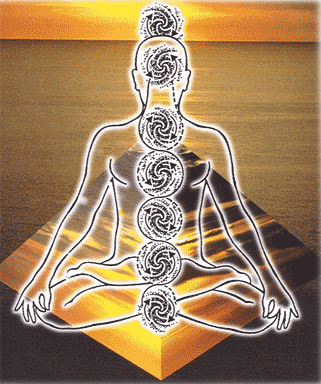
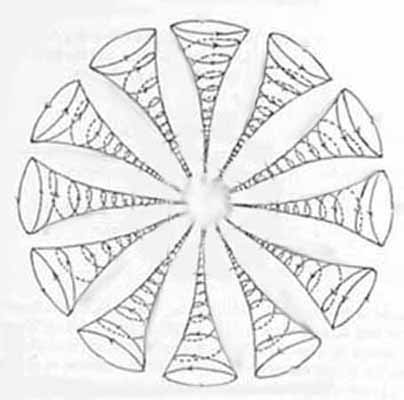
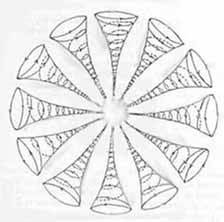
No comments:
Post a Comment